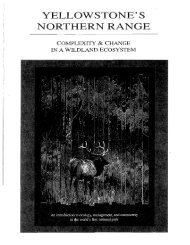Predictive models of whitebark pine mortality from mountain pine ...
Predictive models of whitebark pine mortality from mountain pine ...
Predictive models of whitebark pine mortality from mountain pine ...
Create successful ePaper yourself
Turn your PDF publications into a flip-book with our unique Google optimized e-Paper software.
506 D.L. Perkins, D.W. Roberts / Forest Ecology and Management 174 (2003) 495–510<br />
Olsen et al., 1996). Susceptibility refers to stand or<br />
tree characteristics independent <strong>of</strong> beetle population<br />
levels (Shore and Safranyik, 1992; Bentz et al., 1993).<br />
Tree and stand-level characteristics associated with<br />
attack are qualitatively similar to other <strong>mountain</strong> <strong>pine</strong><br />
beetle–<strong>pine</strong> host systems, although the attack thresholds<br />
are quantitatively different. For instance, <strong>whitebark</strong><br />
<strong>pine</strong> stands with basal areas below 10 m 2 /ha<br />
(44 ft 2 /acre) and trees with average diameters below<br />
18 cm (7 in.) were not attacked in the early 20th<br />
century epidemic in central Idaho. These are the same<br />
variables identified for susceptible lodgepole <strong>pine</strong><br />
stands where basal areas below 18 m 2 /ha (80 ft 2 /acre)<br />
and average diameters less than 20 cm (8 in.) are<br />
seldom attacked (Cole and Amman, 1969; Amman<br />
et al., 1977) and in ponderosa <strong>pine</strong> (Pinus ponderosa<br />
(Doug.) stands where high probabilities <strong>of</strong> attack are<br />
associated with 27–34 m 2 /ha (120–150 ft 2 /acre) basal<br />
area (Sartwell and Stevens, 1975; Schmid and Mata,<br />
1992) and average mean diameters <strong>of</strong> greater than<br />
20 cm (8 in.) (Stevens et al., 1980; Sartwell and<br />
Stevens, 1975). Our work presents evidence <strong>of</strong> the<br />
generality <strong>of</strong> host susceptibility characteristics across<br />
<strong>pine</strong> species and over elevation gradients.<br />
Quantifying ‘risk’ as opposed to ‘susceptibility’ <strong>of</strong><br />
stands and trees to <strong>mountain</strong> <strong>pine</strong> beetle infestation<br />
requires evaluation <strong>of</strong> population levels <strong>of</strong> beetles<br />
(Shore and Safranyik, 1992; Bentz et al., 1993). An<br />
epidemic by definition, requires high levels <strong>of</strong> <strong>mountain</strong><br />
<strong>pine</strong> beetles. The epidemic <strong>of</strong> the 1909–1940<br />
period in central Idaho was documented in lodgepole<br />
<strong>pine</strong>, limber <strong>pine</strong> (Pinus exilis James) and <strong>whitebark</strong><br />
<strong>pine</strong> forests (Renner, 1929) and <strong>mortality</strong> levels <strong>of</strong><br />
<strong>whitebark</strong> <strong>pine</strong> were high (Perkins and Swetnam,<br />
1996). Beetles were reported to have dispersed <strong>from</strong><br />
lower elevation lodgepole forest into high elevation<br />
<strong>whitebark</strong> <strong>pine</strong> stands (Arno, 1970; Ciesla and Furniss,<br />
1975; Arno, 1986; Arno and H<strong>of</strong>f, 1989; Schmitt<br />
and Scott, 1998). Although conclusive empirical evidence<br />
has not been presented to support dispersal <strong>of</strong><br />
beetles <strong>from</strong> one host type to another, these stands<br />
were not only susceptible as described by tree and<br />
stand structural characteristics, but were also at high<br />
risk <strong>of</strong> infestation because <strong>of</strong> high levels <strong>of</strong> <strong>mountain</strong><br />
<strong>pine</strong> beetles in nearby lodgepole <strong>pine</strong> stands.<br />
Whitebark <strong>pine</strong> trees with multiple stems in tree<br />
clusters are more likely to be attacked than single<br />
stems. This indicates that distance between stems is a<br />
factor in the probability <strong>of</strong> <strong>mountain</strong> <strong>pine</strong> beetle<br />
attack. Donnegan and Rebertus (1999) also found that<br />
<strong>mortality</strong> <strong>of</strong> mid-successional stage limber <strong>pine</strong> was<br />
correlated with its clumped or clustered pattern. The<br />
nstms variable indirectly incorporates a spatial component<br />
identified by Bentz et al. (1993) to improve risk<br />
rating systems and by Powell et al. (1996) to incorporate<br />
dispersal effects. This is a simple metric useful<br />
for bird dispersed <strong>pine</strong>s whose growth forms are the<br />
result <strong>of</strong> the seed caching behavior <strong>of</strong> birds. Mitchell<br />
and Preisler (1991) used a logistic regression spatial<br />
analysis <strong>of</strong> lodgepole <strong>pine</strong> attack by <strong>mountain</strong> <strong>pine</strong><br />
beetles and found that among small diameter classes<br />
spatial relationships among trees and tree size were the<br />
most important covariates. That small diameter <strong>whitebark</strong><br />
<strong>pine</strong> trees were attacked may be related more to<br />
their proximity to larger stems in tree clusters than to<br />
their size alone.<br />
High elevations are generally associated with<br />
decreasing beetle-caused <strong>mortality</strong> levels because <strong>of</strong><br />
unfavorable heat balance for beetle development<br />
(Amman, 1973; Logan and Bentz, 1999). However,<br />
elevation is not correlated with beetle attack <strong>of</strong> trees or<br />
stands during the epidemic conditions <strong>of</strong> the ca. 1930<br />
outbreak. This may be explained in part by the narrow<br />
elevation band 300 m (1000 ft) <strong>of</strong> the study area and<br />
the fact that differences in elevation among sites were<br />
imperceptible. Additionally, aspect and slope, site<br />
variables frequently used as surrogates for radiation<br />
loads, were not significantly correlated ðp > 0:01Þ<br />
with beetle attack. However, climatic conditions during<br />
the ca. 1930 epidemic were characterized by above<br />
average departures in summer temperatures (Finklin,<br />
1988; Perkins and Swetnam, 1996; Biondi et al.,<br />
1999). This likely contributed to the outbreak’s extent<br />
and magnitude by improving conditions for the <strong>mountain</strong><br />
<strong>pine</strong> beetle by resulting in an adaptive seasonality<br />
(Logan and Bentz, 1999; Logan and Powell, 2001).<br />
Beetle development is under direct temperature control<br />
(Logan and Bentz, 1999) and warm temperatures<br />
would likely have favored successful brood development,<br />
beetle survivorship, and successful attacks<br />
(Reid and Gates, 1970; Amman, 1972, 1973; Bentz<br />
et al., 1991; Logan and Bentz, 1999).<br />
Another noteworthy observation is that infestation<br />
occurred at the start <strong>of</strong> the longest sustained low<br />
growth period for the last 200 years as revealed in<br />
<strong>whitebark</strong> tree-ring width chronologies (Perkins,















